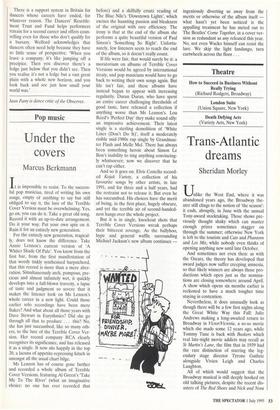Pop music
Under the covers
Marcus Berkmann
It is impossible to resist. To the success- ful pop musician, tired of writing his own songs, empty of anything to say but still obliged to say it, the lure of the Terrible Cover Version must be overwhelming. Yes, go on, you can do it. Take a great old song. Record it with an up-to-date arrangement. Do it your way. Put your own spin on it. Ruin it for an entirely new generation.
For the entirely new generation, tragical- ly, does not know the difference. Take Annie Lennox's current version of 'A Whiter Shade Of Pale'. You know from the first bar, from the first manifestation of that weedy tinkly synthesised harpsichord, that this record is more than a mere aber- ration. Simultaneously arch, pompous, pre- cious and almost infinitely wet, it quickly develops into a full-blown travesty, a lapse of taste and judgment so severe that it makes the listener look on Ms Lennox's whole career in a new light. Could those earlier solo recordings have been mere flukes? And what about all those years with Dave Stewart in Eurythmics? Did she go through all that to produce . . . this? No, she has just succumbed, like so many oth- ers, to the lure of the Terrible Cover Ver- sion. Her record company RCA clearly recognises its significance, and has released it as a single. It now sits happily in the top 20, a lacuna of appetite-repressing kitsch in amongst all the usual chart bilge.
Ms Lennox has of course gone further and recorded a whole album of Terrible Cover Versions, featuring Al Green's 'Take Me To The River' (what an imaginative choice: no one has ever recorded that before) and a skilfully ersatz reading of The Blue Nile's 'Downtown Lights', which excises the haunting passion and bleakness of the original with rare efficiency. The irony is that at the end of the album she performs a quite beautiful version of Paul Simon's 'Something So Right'. Unfortu- nately, few listeners seem to reach the end of the album, so it doesn't really count.
If life were fair, that would surely be it: a moratorium on albums of Terrible Cover Versions would be agreed by international treaty, and pop musicians would have to go back to writing their own songs again. But life isn't fair, and these albums have instead begun to appear with increasing regularity. Duran Duran, who have spent an entire career challenging thresholds of good taste, have released a collection if anything worse than Ms Lennox's. Lou Reed's 'Perfect Day' they make sound silly: an impressive achievement. Their latest single is a sterling demolition of 'White Lines (Don't Do It)', itself a moderately risible mid-1980s rap single by Grandmas- ter Flash and Melle Mel. There has always been something heroic about Simon Le Bon's inability to sing anything convincing- ly whatsoever; now we discover that he can't rap either.
And so it goes on. Elvis Costello record- ed Kojak Variety, a collection of his favourite songs by other artists, in late 1991, and for three and a half years, had the restraint not to release it. But even he has succumbed. His choices have the merit of being, in the first place, hugely obscure, and yet the terrible air of second-handed- ness hangs over the whole project.
But it is in single, knockout shots that Terrible Cover Versions wreak perhaps their bitterest revenge. As the ballyhoo, hype and general waffle surrounding Michael Jackson's new album continues — ingeniously diverting us away from the merits or otherwise of the album itself what hasn't yet been noticed is the appalling treatment he has meted out to The Beatles' Come Together, in a cover ver- sion as redundant as any released this year. No, not even Wacko himself can resist the lure. We skip the light fandango, turn cartwheels across the floor . . .


































































 Previous page
Previous page